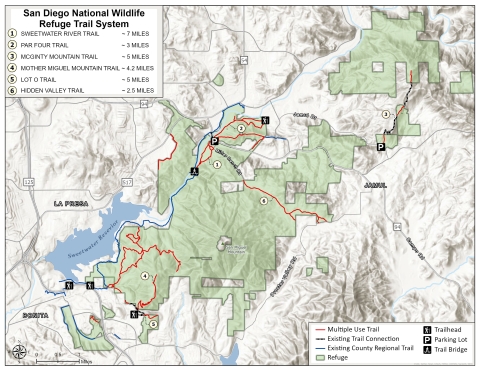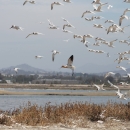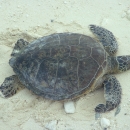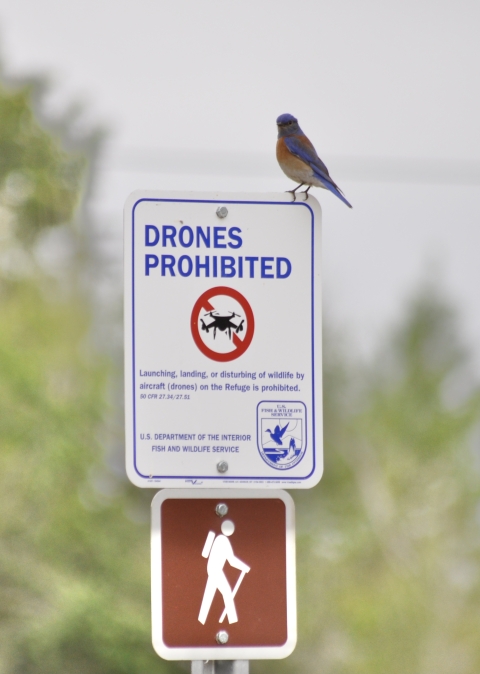Visit Us
San Diego National Wildlife Refuge offers one of the last expanses of open space in coastal southern California with exceptional biological, social, historical, and economic values and is protected as a sanctuary not just for plants and animals but also for people. Visitors have the opportunity to go hiking, biking, birding, and horseback riding as well as photograph endangered species and get a private tour from a refuge ranger.
There are no restrooms or drinking water fountains on the refuge. If visiting Mother Miguel Mountain, the only place where there are restrooms are at the Mount San Miguel Park, a community sports park open from 7 a.m. – 10 p.m. Visitors closer to the Sweetwater Loop can find restrooms at the nearby shopping area located between Campo Road and Jamacha Road.
Activities
The primary use of the Refuge is as habitat to support native species, particularly listed and sensitive species. Other currently authorized activities on the Refuge are:
• hiking, mountain biking, and horseback riding on the County of San Diego’s Sweetwater River Trail and Par Four Trail;
• hunting;
• guided hikes to support wildlife observation and photography, interpretation, environmental education;
• ranger-led programs and events!
Wildlife & Habitat
The San Diego National Wildlife Refuge supports an extremely diverse assemblage of habitat types and species. More than 14 species are currently listed as threatened or endangered, including some species addressed in the San Diego Multiple Species Conservation Program (MSCP). Although a comprehensive wildlife inventory has not yet been completed for the refuge; however, various surveys have been conducted over the years for different portions of the Refuge. More information about the wildlife present on the Refuge is provided in the Comprehensive Conservation Plan.
Trails
There are four main trailheads at the San Diego National Wildlife Refuge. These trails are the best areas for viewing the diverse wildlife of the San Diego National Wildlife Refuge. Here, habitats include coastal sage scrub, riparian riparian
Definition of riparian habitat or riparian areas.
Learn more about riparian forest, and chaparral communities, and are home to many threatened and endangered species. Trails are currently open to hiking, biking, and horseback riding. Be sure to bring your binoculars and camera!
Also, be prepared with your essential outdoor items, especially water, and use the restroom before you come to the refuge.
We have no public restrooms or drinking water on our lands. Camping is not allowed.
Trailheads:
Sweetwater Interpretive Loop
Par 4 Drive Trailhead
McGinty Mountain Trailhead
Mother Miguel Mountain Trailhead
Other Facilities in the Complex
San Diego National Wildlife Refuge is managed as part of the San Diego National Wildlife Refuge Complex. The Refuge complex is comprised of Seal Beach NWR, San Diego Bay NWR, San Diego NWR, and Tijuana Slough NWR.
Rules and Policies
Drones are NOT ALLOWED.
Launching, landing or disturbing of wildlife by aircraft (drones) is prohibited. 50 CFR 27.34/27.51
Stay on trails.
If a trail looks too narrow, is eroding, or is too uneven/steep, then do not take it. The refuge is currently undergoing a trail system plan. Until the trails are finalized, please use trail ethic to respect other trail users. Pedestrians and bicycles yield to horses, bicycles yield to pedestrians.
Geocaching is not allowed.
The placement of geocaches on national wildlife refuges is prohibited. This is due in part to Federal regulations that prohibit the abandonment of property (50 CFR 27.93) on any national wildlife refuge national wildlife refuge
A national wildlife refuge is typically a contiguous area of land and water managed by the U.S. Fish and Wildlife Service for the conservation and, where appropriate, restoration of fish, wildlife and plant resources and their habitats for the benefit of present and future generations of Americans.
Learn more about national wildlife refuge , but also because such activity can result in disturbance to or destruction of refuge resources. As a result, all caches found on the Refuge are removed.
Be aware of wildlife that could take your presence by surprise.
Rattlesnakes love to come out when the sun is shining. They can also be hiding under rocks, so do not ever step on rock piles. If you see a rattlesnake, go around it or turn around and leave. If you get bit by mistake, remain calm, call 911, and if you have a fellow hiker to help you, get to an area where an emergency vehicle can come pick you up.
Mountain lions have been seen in the vicinity of the refuge, however encounters with them are rare. Make sure you know how to stay safe in mountain lion habitat.
Keep dogs on a leash at all times.
Keeping your dog on a leash is not only a county-wide law, but prevents wildlife disturbance on the refuge, safer for the other hikers/dogs on the trail, and prevents your dog from getting bitten by a rattlesnake.
Pick up after your dog or horse.
Leaving your animal's waste is not only disturbing to other hikers and wildlife, it severely contaminates the water after rains. Almost all creeks drain to the Sweetwater River or Otay River, which is drinking water for the citizens of San Diego.
Do not use the refuge night.
The refuge is open sunrise to sunset and closed at night.
Try to hike with a buddy.
It is wisest to not hike alone.
If you see something disturbing or unlawful, please contact the Refuge Manager. Call 911 for emergencies.
Please make sure you know the date, time, and location of the unlawful activity. Contact Refuge Manager Dwane Binns at Dwane_Binns@fws.gov or (619) 385-1190.
Locations













The San Diego National Wildlife Refuge staff office is located on the Rancho Jamul Ecological Reserve, managed by the California Department of Fish & Wildlife. The office is not open to the public, however there are volunteer events frequently organized there. Here is the contact information for the San Diego National Wildlife Refuge.
14715 Highway 94/PO Box 746
Jamul, CA 91935
Complex Headquarters' number 619-221-3473
Refuge Manager cell phone: 619-385-1190
















We are pleased to announce that a new one-acre gravel-surfaced parking lot, located off State Route 94 at Millar Ranch Road in Rancho San Diego, is open for public use.
Address: 12155 Campo Rd, El Cajon, CA 92019
This is a one-acre gravel-surfaced parking lot that accommodates about 40 vehicles, including five pull-through spaces for equestrian trailers and school buses, and two handicapped accessible spaces. This parking area allows visitors to access the Sweetwater Interpretive Loop trail, which connects to the county’s Sweetwater River Regional Trail, and supports current and future interpretive, environmental education, and habitat restoration programs.
From the west (San Diego):
94 East toward Rancho San Diego. 94 eventually turns into Jamacha Rd.
When you get to the intersection of Campo Road (which also continues as HWY 94), turn right, passing the large shopping center on the left.
Shortly you will turn right on Millar Ranch Road, and arrive at the parking area right after the old steel bridge.
Park and head towards the kiosk that is next to the trail head.
From the east (El Cajon):
Head west on Jamacha until you get to Campo Rd (HWY 94) and turn left.
Turn right on Millar Ranch Road. and park in the lot. Follow the rest of the above directions.
From the South (Jamul/Dulzura/Campo):
Head North on HWY 94 (Campo Rd.), turn left onto Millar Ranch Road. Follow the rest of the above directions.
From the north:
There are several freeways that can take you south where it meets up with HWY 94 East. Follow above directions from there.







